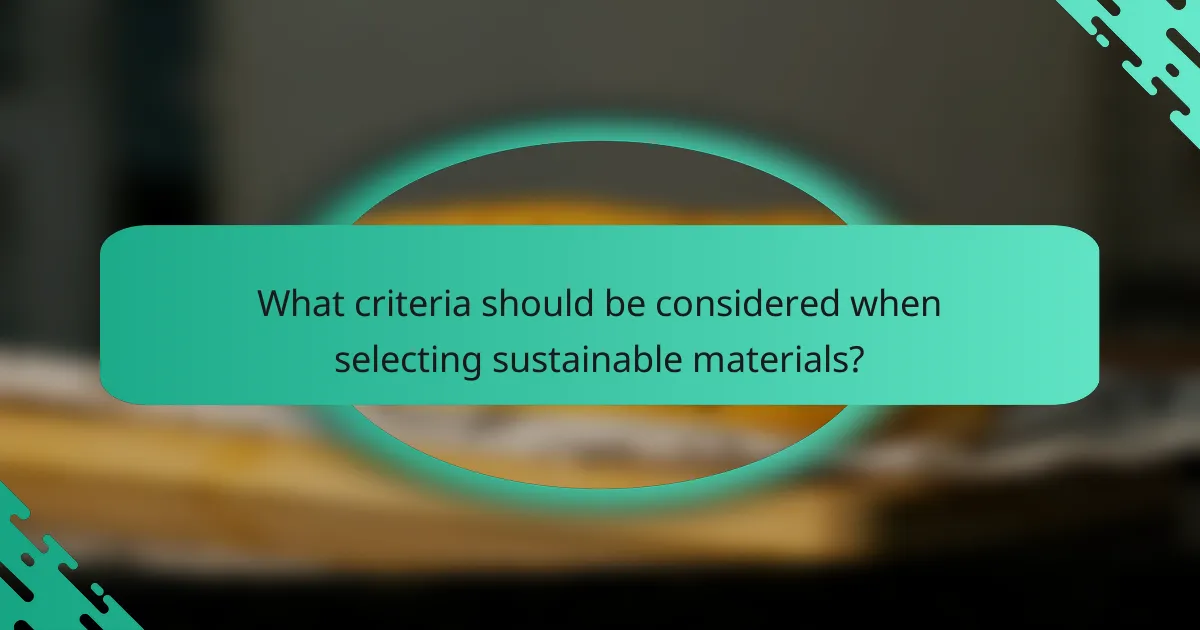Sustainable design is an essential approach that integrates eco-friendly materials and practices to minimize environmental impact while enhancing the functionality and aesthetics of spaces. In Los Angeles, a variety of sustainable materials are available, promoting energy efficiency and water conservation. By adopting these practices, businesses can benefit from cost savings, improved public perception, and increased asset value, ultimately leading to a more sustainable future.

What are the sustainable design materials available in Los Angeles?
Los Angeles offers a variety of sustainable design materials that cater to eco-friendly construction and renovation. These materials not only reduce environmental impact but also enhance the aesthetic and functional qualities of spaces.
Bamboo
Bamboo is a rapidly renewable resource that grows much faster than traditional hardwoods, making it an excellent choice for sustainable design. Its strength and versatility allow it to be used in flooring, furniture, and even structural applications.
When selecting bamboo products, look for those certified by organizations like the Forest Stewardship Council (FSC) to ensure responsible sourcing. Local suppliers in Los Angeles often provide a range of bamboo options that meet these standards.
Recycled steel
Recycled steel is a durable and sustainable material that significantly reduces the need for new metal production. Using recycled steel can lower energy consumption and greenhouse gas emissions associated with manufacturing.
In Los Angeles, many construction projects incorporate recycled steel in framing and roofing. Ensure that the steel is sourced from reputable suppliers who can verify its recycled content to maximize sustainability benefits.
Low-VOC paints
Low-VOC (volatile organic compounds) paints are designed to minimize harmful emissions during application and drying. These paints contribute to better indoor air quality, making them a smart choice for residential and commercial spaces.
When choosing low-VOC paints in Los Angeles, look for products that comply with California’s stringent air quality regulations. Many local retailers offer a variety of colors and finishes that meet these eco-friendly standards.
Reclaimed wood
Reclaimed wood is sourced from old buildings, furniture, or other structures, giving it a second life while reducing the demand for new timber. This material adds character and history to design projects while being environmentally responsible.
In Los Angeles, reclaimed wood can be found at specialty lumber yards and architectural salvage stores. Ensure that the wood is treated for pests and mold to maintain its integrity in new applications.
Biodegradable plastics
Biodegradable plastics are designed to break down more quickly than traditional plastics, reducing landfill waste and environmental impact. These materials are increasingly used in packaging, furniture, and decorative elements.
When selecting biodegradable plastics, check for certifications that confirm their compostability. Local manufacturers in Los Angeles are beginning to adopt these materials, providing innovative options for sustainable design.

How can sustainable design practices be implemented locally?
Sustainable design practices can be implemented locally by focusing on energy efficiency, water conservation, and utilizing natural resources effectively. These approaches not only reduce environmental impact but also enhance the quality of life in communities.
Energy-efficient building techniques
Energy-efficient building techniques involve using materials and designs that minimize energy consumption. Key methods include proper insulation, energy-efficient windows, and the use of sustainable materials like bamboo or recycled steel.
Consider incorporating features such as green roofs or reflective materials to reduce heat absorption. Local regulations may offer incentives for energy-efficient upgrades, so check for available programs that can offset initial costs.
Water conservation systems
Water conservation systems are essential for reducing water waste and managing resources sustainably. Techniques include rainwater harvesting, greywater recycling, and installing low-flow fixtures.
Implementing these systems can significantly lower water bills and reduce strain on local water supplies. For instance, a rainwater collection system can provide irrigation for gardens, which is particularly beneficial in regions with variable rainfall.
Passive solar design
Passive solar design utilizes the sun’s energy for heating and cooling without mechanical systems. This includes strategic placement of windows, thermal mass materials, and overhangs to control sunlight exposure throughout the year.
To maximize effectiveness, orient buildings towards the sun and use materials that retain heat during colder months. Local climate conditions will influence design choices, so consider seasonal variations when planning passive solar features.

What are the benefits of sustainable design for businesses in California?
Sustainable design offers numerous advantages for businesses in California, including cost efficiency, improved public perception, and increased asset value. By adopting eco-friendly practices, companies can not only reduce their environmental impact but also enhance their operational performance and profitability.
Cost savings on utilities
Implementing sustainable design can lead to significant cost savings on utilities for businesses in California. Energy-efficient systems, such as LED lighting and high-efficiency HVAC units, can reduce electricity bills by up to 30% or more. Additionally, water-saving fixtures and irrigation systems can lower water costs, which is particularly beneficial in drought-prone areas.
To maximize utility savings, businesses should consider conducting an energy audit to identify areas for improvement. Investing in renewable energy sources, like solar panels, can further decrease reliance on grid power and provide long-term financial benefits through tax incentives and rebates.
Enhanced brand reputation
Adopting sustainable design practices can significantly enhance a business’s brand reputation in California. Consumers are increasingly drawn to companies that prioritize environmental responsibility, which can lead to increased customer loyalty and market share. Businesses that showcase their commitment to sustainability often enjoy positive media coverage and community support.
To strengthen brand reputation, companies should communicate their sustainability efforts clearly through marketing materials and social media. Engaging in local environmental initiatives and obtaining certifications, such as LEED or Green Business Certification, can also bolster credibility and attract eco-conscious customers.
Increased property value
Sustainable design can lead to increased property values for businesses in California. Properties that incorporate green building practices often command higher resale prices and attract more tenants due to lower operating costs and enhanced appeal. Features like energy-efficient windows and sustainable materials can make a property more desirable in a competitive market.
Business owners should consider investing in sustainable upgrades, such as green roofs or energy-efficient appliances, to improve property value. Additionally, understanding local market trends and regulations related to sustainability can help in making informed decisions that maximize investment returns.

What are the current trends in sustainable design?
Current trends in sustainable design focus on integrating technology, utilizing local resources, and promoting a circular economy. These practices not only reduce environmental impact but also enhance the efficiency and appeal of built environments.
Smart home technology integration
Smart home technology is increasingly being incorporated into sustainable design to improve energy efficiency and user convenience. Devices such as smart thermostats, energy-efficient lighting, and automated systems allow homeowners to monitor and control energy usage effectively.
When implementing smart technology, consider compatibility with existing systems and the potential for future upgrades. Look for products that adhere to energy efficiency standards, such as ENERGY STAR, to ensure optimal performance.
Use of local materials
Utilizing local materials is a key trend in sustainable design as it reduces transportation emissions and supports local economies. Materials sourced from nearby suppliers often have a lower carbon footprint and can enhance the aesthetic appeal of a project by reflecting regional characteristics.
When selecting local materials, assess their sustainability credentials, such as whether they are renewable or recycled. Examples include reclaimed wood, local stone, and natural fibers, which can contribute to both the environmental and cultural integrity of the design.
Focus on circular economy
The circular economy emphasizes reusing, recycling, and repurposing materials to minimize waste in sustainable design. This approach encourages designers to think beyond the traditional lifecycle of products and consider their end-of-life potential from the outset.
To adopt a circular economy mindset, prioritize materials that can be easily disassembled and reused. Implement strategies such as designing for disassembly and using modular components, which can facilitate future renovations or repurposing.

What criteria should be considered when selecting sustainable materials?
When selecting sustainable materials, consider their environmental impact, durability, and lifecycle. Key criteria include resource renewability, energy efficiency in production, and the potential for recycling or composting at the end of their life.
Environmental impact
Assess the environmental impact of materials by examining their sourcing, production processes, and transportation. Look for materials that are locally sourced to reduce carbon footprints and those that require minimal energy to manufacture. Certifications such as FSC for wood or GOTS for textiles can indicate lower environmental harm.
Durability and lifespan
Durability is crucial for sustainability; longer-lasting materials reduce the need for replacements and conserve resources. Evaluate materials based on their resistance to wear and tear, maintenance requirements, and overall lifespan. For instance, using high-quality metals or treated woods can lead to significant long-term savings and less waste.
Recyclability and compostability
Consider whether materials can be recycled or composted at the end of their life cycle. Materials like certain plastics, metals, and organic textiles can often be repurposed, reducing landfill waste. Familiarize yourself with local recycling programs to ensure proper disposal and to maximize the sustainability of your material choices.


